This post contains affiliate links. If you follow one of my links I earn a small commission at no extra cost to you. All opinions are completely my own. Thank you for supporting my blog!
Well, we made it. We’ve come to the end of my game schooling series. I hope you’ve found some fun new ways to learn with your preschoolers! Our last topic is fine and gross motor skills. I’ve decided to combine the two topics. One, because they go hand and hand. Balancing out both fine and gross motor is beneficial and valuable to your preschoolers growth physically and mentally. And two, because it’s my blog and I do what I want. 😉
Gross motor development involves the larger muscle groups. These muscles control things like the ability to run, jump, and ride a bike. Fine motor skills use smaller muscles for tasks like cutting with scissors and writing. Both are extremely important for brain development as well.
Since preschool aged children generally have enough energy to power a small country, it’s usually not difficult to develop gross motor skills. Especially if they get plenty of outdoor play. Fine motor activities involve a bit more concentration and can sometimes be more challenging, but there are plenty of ways to make it fun!

Our favorite games for gross motor skills practice:
Playing outdoors really is very beneficial to gross motor development. Navigating uneven natural ground, space to run, and the added benefit of tons of sensory input make playing outdoors our favorite gross motor activity.
Being outside is not always an option though. Rain, or more likely where we live in Southern California, heat can make indoor play a better choice. When that’s the case, we have a selection of gross motor activities that we prefer:
1. Roll & Play
This super cute game has an amazingly simple yet effective design. It’s made for kids as young as 18 months and yet my five year old even thinks it’s fun. To play, just roll the plush color cube and draw a card that corresponds with the face up color. The cards then give the player a task to complete, like touch your toes, go find something purple, or give high fives (to name a few). It actually covers quite a few topics, from counting to color recognition, but we love it for staying active on those days indoors.
2. Color Races
I wrote a whole blog post about this one because it’s just so awesome. Super simple, burns tons of energy, and helps them learn their colors! It’s just an all around good time. And takes pretty much zero prep work.
3. Indoor Hopscotch Rug
I mentioned this rug awhile back in my post about our favorite homeschool tools and it’s still a favorite. We don’t get snow where we live, but we do get days with triple digit temps outdoors, so this rug has been great for gross motor indoor fun. Plus, it helps with number recognition and counting. Perfect!
Our favorite games for fine motor practice:
1. Operation
I was tempted to include Operation in my science game schooling post, but it’s just not science-y enough. Know what I mean? While it may have “body parts” they aren’t necessarily accurate. You could take the time to relate the game to the human body in a more scientific way, but there are just better ways to teach anatomy. So I’m putting it under fine motor practice and I think it’s a much more accurate category. The kids love trying to get those little pieces out of the game without hearing the buzzer, but it’s so fun to watch them jump and giggle if they get buzzed.
2. Let’s Go Fishing
This one is great for all ages. It takes patience, and it is difficult for my two year old to hold that fishing pole steady enough. However, he made his own modification, turned the pole backward (so he’s fishing with the end of the rod instead if the string), and it works well for him. It’s still a challenge, but he’s able to catch a fish here and there to boost his confidence.
You can also make your own like the one I mention in my post on our preschool busy binder. Paper fish, metal paper clips, and a magnet on string (or a magnetic “fishing pole” scrounged from a Melissa and Doug puzzle like we do) and you’ve got yourself a fishing game! Add a letter or number on each fish and you can add an educational element as well!
3. Jumbo Tweezers & Clothes Pins
Our pompom color sorting game has been a major part of our busy binder since Squeaks was two. Using some jumbo tweezers to sort the pompoms by color is great for fine motor practice and learning colors. We like to use a jumbo muffin pan to keep the colors separate.
Any game with clothes pins, like my alphabet sorting wheel, number wheel, or color sorting wheel, has always been a hit with my kids. Squeezing those clothes pins to open them is great for fine motor practice and really helps strengthen the muscles that will later be used for gripping a pencil to write.
I have so enjoyed sharing all of our favorite games with you throughout this series (and my kids enjoyed playing them so mom could take pictures! 😉 ).If you missed any of it, check out my series page to see all my game schooling posts. I hope you’ve found some useful tips that you can apply in your own game schooling!
Visit my Game Schooling Series page here!
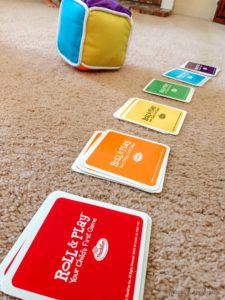
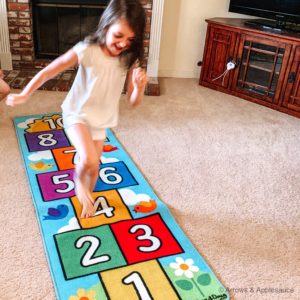

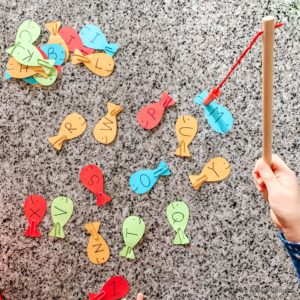
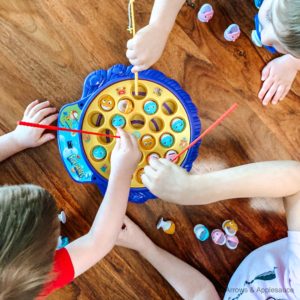
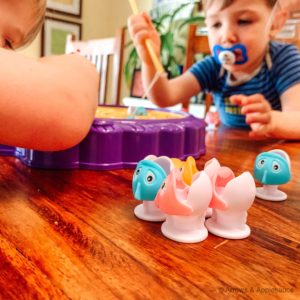
Leave a Reply